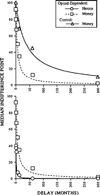The behavioral economics and neuroeconomics of reinforcer pathologies: implications for etiology and treatment of addiction
- PMID: 21732213
- PMCID: PMC4034532
- DOI: 10.1007/s11920-011-0215-1
The behavioral economics and neuroeconomics of reinforcer pathologies: implications for etiology and treatment of addiction
Abstract
The current paper presents a novel approach to understanding and treating addiction. Drawing from work in behavioral economics and developments in the new field of neuroeconomics, we describe addiction as pathological patterns of responding resulting from the persistently high valuation of a reinforcer and/or an excessive preference for the immediate consumption of that reinforcer. We further suggest that, as indicated by the competing neurobehavioral decision systems theory, these patterns of pathological choice and consumption result from an imbalance between two distinct neurobehavioral systems. Specifically, pathological patterns of responding result from hyperactivity in the evolutionarily older impulsive system (which values immediate and low-cost reinforcers) and/or hypoactivity in the more recently evolved executive system (which is involved in the valuation of delayed reinforcers). This approach is then used to explain five phenomena that we believe any adequate theory of addiction must address.
Conflict of interest statement
Dr. Jarmolowicz, Dr. Mueller, and Ms. Gatchalian reported no potential conflicts of interest relevant to this article.
Figures



References
-
-
Bickel WK, Jarmolowicz DP, MacKillop J, et al. The behavioral economics of reinforcement pathologies. In: Shaffer HJ, editor. Addiction syndrome handbook. Washington, DC: American Psychological Association; 2011. This chapter provides an extended description of the concept of reinforcer pathologies as applied to addiction.
-
-
- Bickel WK, DeGrandpre RJ, Higgins ST. Behavioral economics: a novel experimental approach to the study of drug dependence. Drug Alcohol Depend. 1993;33:173–192. - PubMed
Publication types
MeSH terms
Grants and funding
LinkOut - more resources
Full Text Sources
Medical

